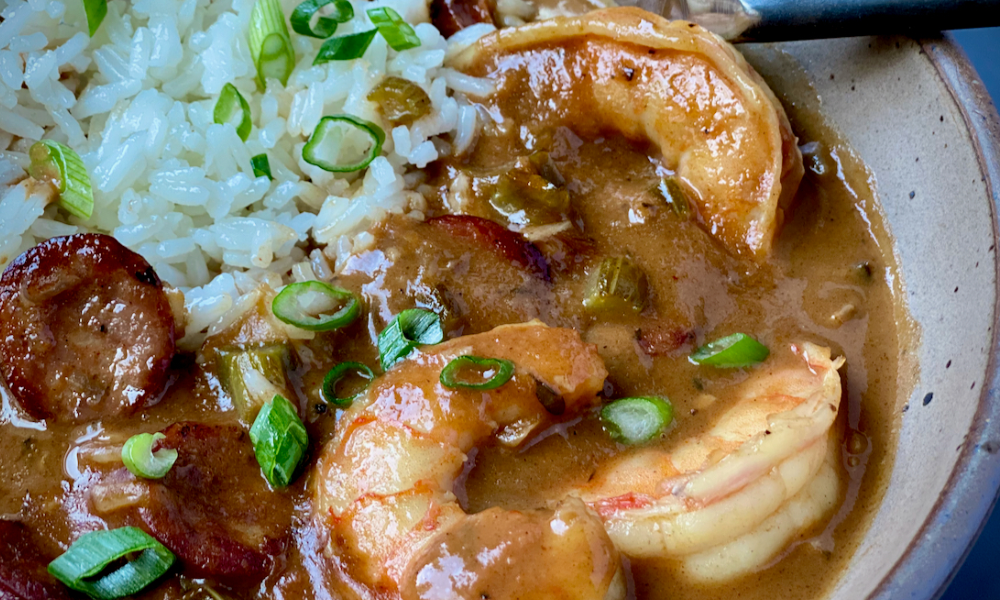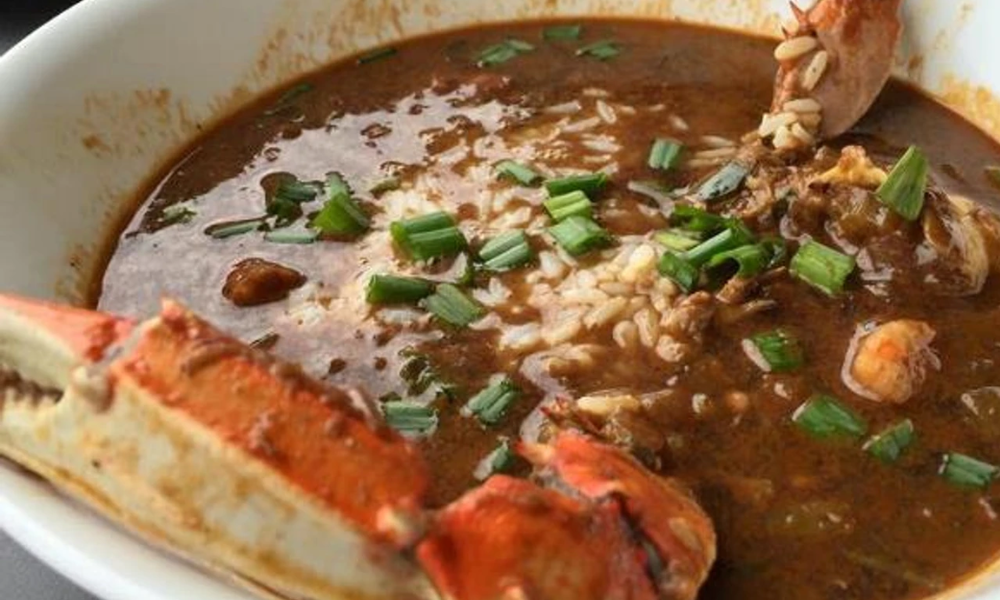The official food of Louisiana in the United States is gumbo, also known as gombo in Louisiana Creole. The “holy trinity” of Creole cuisine, celery, bell peppers, and onions, as well as meat or shellfish (or occasionally both), are the main ingredients of gumbo. Gumbo is frequently classed based on the thickener used, such as okra or filé powder (dried and ground sassafras leaves).
Okra and filé powder are optional additions to gumbo. Shellfish, a dark roux, filé, or both are typically found in creole gumbo. Tomatoes are still utilized in New Orleans cooking and are occasionally seen in Creole gumbo, but many gumbo cooks disagree, claiming that tomatoes should never be added to gumbo. Typically cooked with shellfish or poultry, cajun gumbo is based on a dark roux.
In either kind of gumbo, sausage or ham is frequently added. After the base is made, the meat is added and the vegetables are simmered down. Shellfish and a few spices are added toward the end after the stew has simmered for at least three hours. Filé powder can be added if preferred after the pot has been taken off the heat. Traditionally, rice is served with gumbo. The third and least popular type is the meatless gumbo herbs, which is essentially a gumbo of slow-cooked greens.
What is Gumbo?
Gumbo can include components like chicken, sausage, ham, shrimp, okra, tomatoes, and greens and is a cross between a substantial soup and a thick stew. The ingredients for gumbo include a roux base, holy trinity vegetables (bell peppers, onions, and celery), and a variety of meats and seafood, including andouille sausage.
Cajun gumbo frequently includes chicken and andouille sausage. The holy trinity vegetables may be obtained pre-chopped at almost all major grocery stores, and the raw chicken thighs can be swapped out for shredded rotisserie chicken to increase the recipe’s level of convenience.
On the other hand, the dark roux takes steady stirring over medium heat, so take your time with this step. Burnt roux will result in rushing the process or raising the temperature. In a pinch, busy cooks can choose to bake the roux slowly in the oven, which takes more time but requires less supervision. The roux should become milk chocolate-colored with time and effort, making the gumbo more flavorful and Cajun.
What does Gumbo Taste Like?
Gumbo is a hearty, savory stew made with a range of meats with the distinctive tastes and textures of okra (bittersweet with a slimy texture) and/or sassafras leaves (which have a root beer flavor). Any given gumbo’s specific flavor will depend on the ingredients it contains. Boneless, skinless chicken breast and Andouille sausage are other common combinations. However, the Holy Trinity, a blend of onion, bell pepper, and celery used to flavor a soup base, gives the majority of gumbos a sweetness.
Gumbo Recipe
Ingredients:
- 1 cup all-purpose flour,
- 3-4 cup bacon grease
- 1 cup of celery, roughly chopped
- 1 big onion, diced coarsely
- 1 large, finely chopped green bell pepper
- 2 minced garlic cloves
- 1 pound of sliced andouille sausage
- 3 gallons of water
- 6 beef bouillon cubes
- White sugar, 1 tablespoon
- salt as desired
- two tablespoons of spicy sauce, or as desired
- 12 teaspoons of the Cajun seasoning mix
- three bay leaves
- one-half teaspoon of dried thyme leaves
- 1.45 ounces of stewed tomatoes in a can
- 1 tomato sauce can (6 ounces)
- split into 4 tablespoons of file powder
- 2 tablespoons of bacon fat
- 2 (10-ounce) packets of thawed frozen sliced okra
- 2 teaspoons of white vinegar, distilled
- 1 lb. of lump crab meat
- 3 pounds of medium shrimp that have been peeled and deveined.
- Worcestershire sauce, two tablespoons
Method:
In a big, heavy saucepan over medium-low heat, whisk flour and 3/4 cup bacon fat until smooth. Roux should be heated while being regularly whisked until it turns a deep mahogany color. This could take 20 to 30 minutes; keep an eye on the heat and whisk regularly to prevent burning. Take the pan off the heat and keep whisking until the mixture stops cooking.
Gumbo: In the work bowl of a food processor, combine the celery, onion, green bell pepper, and garlic. Pulse several times to finely chop all the ingredients. Sausage and vegetables are mixed into the roux. Over medium-low heat, bring mixture to a simmer and cook for 10 to 15 minutes, or until veggies are fork-tender. Turn off the heat and leave it aside.
Large Dutch oven or soup pot filled with water and beef bouillon cubes brought to a boil over high heat. Into the boiling water, whisk the roux mixture after stirring until the bouillon cubes have dissolved.
Add sugar, salt, spicy sauce, Cajun seasoning, bay leaves, thyme, stewed tomatoes, and tomato sauce after lowering the heat to a simmer. Cook soup for 1 hour on low heat, adding 2 tablespoons of file gumbo powder after 45 minutes.
Melt 2 tablespoons of bacon drippings in a pan over medium heat in the meantime. Okra and vinegar should be added. After 15 minutes, take the okra with a slotted spoon and incorporate it into the gumbo that is simmering.
Stir in the crabmeat, shrimp, and Worcestershire sauce. Simmer for an additional 45 minutes to let the flavors meld. Just before serving, add 2 additional tablespoons of file gumbo powder.
Where did Gumbo Start?
Gumbo’s beginnings and ends are constantly changing. Gumbo is a combination of several different cuisines that made their way to South Louisiana, including but not limited to African, Native American, and European, due to contradicting accounts of its origin. Gumbo cannot be assigned to a single culture because of this.
We do know that gumbo is representative of the people who established their lives in South Louisiana, despite its somewhat convoluted origin narrative. Since gumbo is frequently associated with Cajun culture, Cajun gumbo includes vegetables that can be found in the river parishes, such as bell peppers, okra, and sassafras (filé powder), as well as shelf-stable flour and oil for the roux.
Every Cajun or Creole restaurant in New Orleans serves gumbo, whether it’s prepared traditionally or uniquely. Saying there is only one gumbo recipe would be an insult to the renowned Southern dish’s essence. Even though gumbo frequently features a roux basis and the holy trinity, it also honors regional ingredients and intricacies of tradition in a variety of ways.
For instance, a well-known French variation of the dish, called Creole gumbo, uses richer components like butter, tomatoes, and shrimp. For Catholics who refrain from meat on Fridays, a vegetarian gumbo known as Gumbo Z’Herbes, which substitutes robust greens for meat, is also popular in South Louisiana during Lent. The gumbo continuum has a place for each variant.
What’s the Difference Between Gumbo and Jambalaya?
The role of rice and the presence of roux are the primary distinctions between jambalaya and gumbo. Jambalaya is the Louisianan version of a paella, where the main ingredient is rice.
For jambalaya, different proteins like chicken, sausage, or shellfish are combined with lightly cooked rice in broth.
Gumbo, on the other hand, comes with rice on the side. Jambalaya doesn’t need a roux, but gumbo also needs one to thicken the stew.
What is a Gumbo File?
Sassafras leaves are dried and used to make a gumbo file or file powder. Gumbo file, which has a rich, earthy flavor akin to thyme and should be added to gumbo in the last few minutes of cooking for an authentic taste of New Orleans, helps to thicken and enrich the stew.
How to Freeze Gumbo?
Gumbo can be frozen for up to three months. Pour the gumbo into serving-sized containers, leaving about an inch of space above each one. Then, transfer the containers to the freezer’s center after carefully sealing each container and checking the seal.
Making sure the gumbo is extremely hot before freezing is the best first step. Although waiting until everything cools before putting it in the freezer seems contradictory, it can help keep the food as fresh as possible, which will be great for the texture and flavor of the gumbo itself.
Once it’s hot and freshly prepared, you can begin freezing it:
Gather as many portion-sized containers as you have on hand and prepare them for freezing gumbo. Fill each container to about four-fifths full. Because doing things that way will allow the gumbo to somewhat expand, we advise doing them that way.
Cool: Be cautious to give the gumbo in the containers time to gradually recover to room temperature. Simply leave the lids off the containers and let the gumbo cool gradually is how to accomplish. This may require several hours.
Seal: Place the lids on the containers after the gumbo has reached room temperature. Examine the edges to make sure they are completely sealed.
Label and Freeze: Before putting the containers in the freezer, clearly label each one. The containers will freeze effectively in the freezer’s center, so put them there.
How does Gumbo Defrost?
The quickest approach to thaw gumbo is to place it in the microwave, remove the cover from the container it was frozen in, and cook it on full power for 30 seconds at a time until it is thoroughly steaming. That will guarantee that it is as safe to ingest as feasible. It can also slowly thaw overnight in the refrigerator. It can then be cooked up in a pan over low heat after it has thawed.
Conclusion
Southern Louisianan stew known as gumbo is thick and delicious. Okra is a staple ingredient in practically all gumbos, including gumbo herbs, chicken, sausage, shrimp, and seafood gumbo. The Creole term “gumbo” is most likely derived from the Bantu word for okra, ki Negombo, or just “gombo” for short.
Gumbo is an excellent illustration of the fusion of French, Native American, and West African culinary traditions: West Africans frequently eat okra stew; Choctaw Native Americans frequently consumed cooked fish and thickened their cuisine with sassafras leaves, and French-style roux offers yet another thickener. The exact origins of gumbo are as obscure as the stew itself, although the first cookbooks published in New Orleans at the turn of the nineteenth century contained gumbo recipes.

